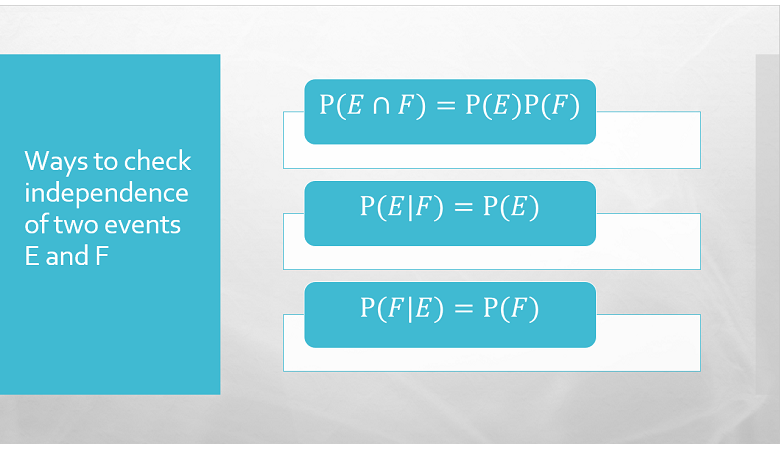Two events are said to be independent if the occurrence of one of them makes it neither more nor less probable that the other occurs.
Let
and
be two events.
After receiving the information that
will happen, we revise our assessment of the probability that
will happen, by computing the conditional
probability of
given
.
The events
and
are said to be independent if the
probability of
remains the same as it was before receiving the
information:
and,
conversely,
In standard probability theory, rather than characterizing independence by properties (1) and (2) above, we define it in a more compact way, as follows.
Definition
Two events
and
are said to be independent events if and only
if
It is easy to prove that this definition implies properties (1) and (2) above.
Suppose
and
are independent and
.
Then,
Note
that we have assumed
.
When
,
things are more complicated (see the discussion about division by zero in the
lecture on
conditional
probability and in the references therein). It is exactly because of the
difficulties that arise in defining
when
that a general definition of independence is not given by using properties (1)
and (2).
The following example shows how to check whether two events are independent in a simple probabilistic experiment.
Example
An urn contains four balls
,
,
and
.
We draw one of them at random. The
sample space
is
Each
of the four balls has the same probability of being drawn, equal to
,
that
is,
![]() Define
the events
Define
the events
and
as
follows:
Their
respective probabilities
are
![[eq13]](/images/independent-events__33.png) The
probability of the event
The
probability of the event
is
![]() Hence,
Hence,As
a consequence,
and
are independent events.
As shown in the previous example, the easiest way to check the independence of
two events
and
is to verify that the standard definition applies:
compute the product of the probabilities of
and
;
compute the probability of
;
if the two quantities computed in step 1 and 2 are equal, then the two events are independent.
However, one could also verify that condition (1) above holds because
![[eq16]](/images/independent-events__44.png) or
that condition (2) holds
because
or
that condition (2) holds
because![[eq17]](/images/independent-events__45.png)
The ways to check independence are summarized in the following infographic.

The definition of independence can be extended also to collections of more than two events.
Definition
Let
,
...,
be
events.
,
...,
are jointly independent (or mutually independent) if and only
if for any sub-collection of
events
(
)
,
...,
:
Let
,
...,
be a collection of
events. It is important to note that even if all the possible couples of
events are independent (i.e.,
is independent of
for any
),
this does not imply that the events
,
...,
are
jointly independent. This is proved with a simple counter-example.
Example
Consider the experiment presented in the previous example (extracting a ball
from an urn that contains four balls). Define the events
,
and
as
follows:
It
is immediate to show
that
![[eq20]](/images/independent-events__68.png) Thus,
all the possible couple of events in the collection
Thus,
all the possible couple of events in the collection
,
,
are independent. However, the three events are not jointly independent. In
fact,
![]()
On the contrary, it is obviously true that if
,
...,
are jointly independent, then
is independent of
for any
.
If
is a zero-probability event, then
is independent of any other event
.
Note
thatAs
a consequence, by the monotonicity of
probability,
But
,
so
.
Since probabilities cannot be negative, it must be
.
The latter fact implies
independence:
Below you can find some exercises with explained solutions.
Suppose that we toss a die. Six numbers (from
to
can appear face up, but we do not yet know which one of them will appear. The
sample space
is
Each
of the six numbers is a sample point and is assigned probability
.
Define the events
and
as
follows:
Prove
that
and
are independent events.
The probability of
is
The
probability of
is
![[eq31]](/images/independent-events__99.png) The
probability of
The
probability of
is
and
are independent events
because
A firm undertakes two projects,
and
.
The probabilities of having a successful outcome are
for project
and
for project
.
The probability that both projects will have a successful outcome is
.
Are the two outcomes independent?
Denote by
the event "project
is successful", by
the event "project
is successful" and by
the event "both projects are successful". The event
can be expressed
as
If
and
are independent, it must be
that
Therefore,
the two outcomes are not independent.
A firm undertakes two projects,
and
.
The probabilities of having a successful outcome are
for project
and
for project
.
What is the probability that neither of the two projects will have a
successful outcome if their outcomes are independent?
Denote by
the event "project
is successful", by
the event "project
is successful" and by
the event "neither of the two projects is successful". The event
can be expressed
as:
where
and
are the complements of
and
.
Using De Morgan's law
(
)
and the formula for the probability of a complement, we
obtain
By
using the formula for the probability of a union, we
obtain
Finally,
since
and
are independent, we have
that
Please cite as:
Taboga, Marco (2021). "Independent events", Lectures on probability theory and mathematical statistics. Kindle Direct Publishing. Online appendix. https://www.statlect.com/fundamentals-of-probability/independent-events.
Most of the learning materials found on this website are now available in a traditional textbook format.